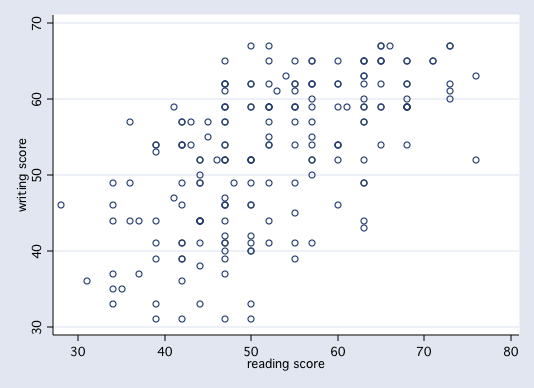
Let's consider two variables from the hsb2 dataset, write and read. In this example we will consider write to be our response variable and read to be our predictor variable, i.e., we want to be able to predict write from knowledge of read. Here is a scatter plot of the two variables.

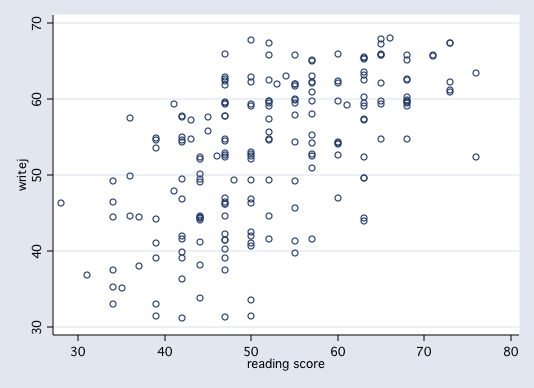
Variable | Obs Mean Std. Dev. Min Max
-------------+--------------------------------------------------------
write | 27 50.62963 9.245157 31 65
3* | 1
3. | 79
4* | 01124
4. | 6667
5* | 22244
5. | 77999
6* | 1222
6. | 5
We can do this for each of the values of read. Here is the frequency distribution and mean
value of write for each value of read.
read | N mean write
---------+--------------------------
28 | 1 46.00
31 | 1 36.00
34 | 6 40.67
35 | 1 35.00
36 | 3 50.00
37 | 2 40.50
39 | 8 43.63
41 | 2 53.00
42 | 13 46.00
43 | 2 55.50
44 | 13 44.92
45 | 2 56.00
46 | 1 52.00
47 | 27 50.63
48 | 1 49.00
50 | 18 49.17
52 | 14 56.00
53 | 1 61.00
54 | 1 63.00
55 | 13 54.77
57 | 14 56.86
60 | 9 56.44
61 | 1 59.00
63 | 16 57.00
65 | 9 62.56
66 | 1 67.00
68 | 11 60.27
71 | 2 65.00
73 | 5 63.40
76 | 2 57.50
---------+--------------------------
Total | 200 52.78
As you can see, some values of of read have only one value of write.
The distribution of write for each value of read is known as the conditional
distribution of write. The means are the conditional means, i.e., the means of
write conditioned on read.
We can plot these conditional means versus read.
These means are the conditional means, i.e., the means of write conditioned on read.
We can plot these means versus read.
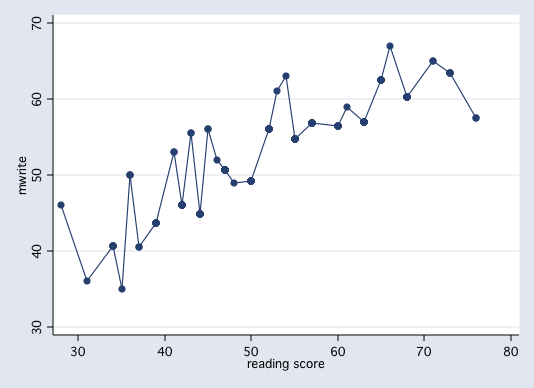
In linear regression we try to explain the change in the conditional mean of the response variable as a linear function of the predictor plus random error, i.e., Y = f(X) + e. We can plot this linear function as a straight line thusly,
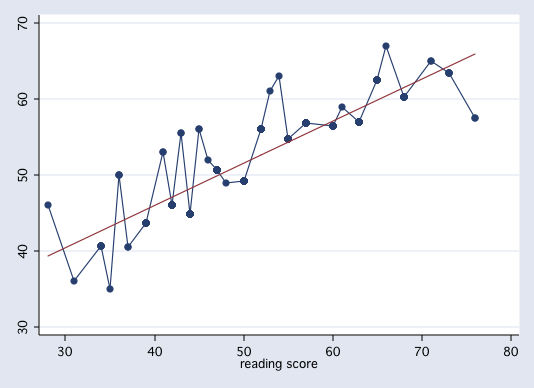
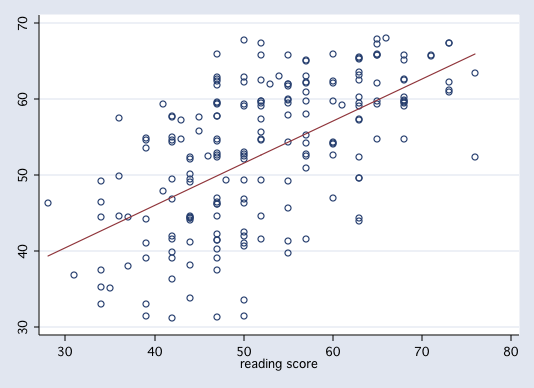
As was stated earlier the function f(X) is a linear function that defines a straight line. Any straight line can be completely determined by two parameters, the slope (b1) and the intercept (b0). For our example, b0 = 23.96 andb1 = 0.55, i.e., predicted write = f(x) = 23.96 + 0.55*read. In other words, the regression line is the line of all possible predicted values. Here is a table of all possible predicted scores, each of which falls on the least squares regression line.
reading | predicted
score | score
----------+-------------
28 | 39.4072
31 | 41.0623
34 | 42.7174
35 | 43.2691
36 | 43.8208
37 | 44.3725
39 | 45.4759
41 | 46.5794
42 | 47.1311
43 | 47.6828
44 | 48.2345
45 | 48.7862
46 | 49.3379
47 | 49.8896
48 | 50.4413
50 | 51.5447
52 | 52.6481
53 | 53.1998
54 | 53.7515
55 | 54.3032
57 | 55.4066
60 | 57.0617
61 | 57.6135
63 | 58.7169
65 | 59.8203
66 | 60.3720
68 | 61.4754
71 | 63.1305
73 | 64.2339
76 | 65.8890
Here are the results of running a regression of write on read.
------------------------------------------------------------------------------
write | Coef. Std. Err. t P>|t| [95% Conf. Interval]
-------------+----------------------------------------------------------------
read | .5517051 .0527178 10.47 0.000 .4477445 .6556656
_cons | 23.95944 2.805744 8.54 0.000 18.42647 29.49242
------------------------------------------------------------------------------
And here are the results of running a regression of conditional means of write on read.
------------------------------------------------------------------------------
mean write | Coef. Std. Err. t P>|t| [95% Conf. Interval]
-------------+----------------------------------------------------------------
read | .5517051 .0196244 28.11 0.000 .5130053 .5904048
_cons | 23.95944 1.04445 22.94 0.000 21.89977 26.01912
------------------------------------------------------------------------------
Note that the regression slopes and intercepts are the same in both models but that the
standard errors are different. The standard errors in the first model are the correct ones.
